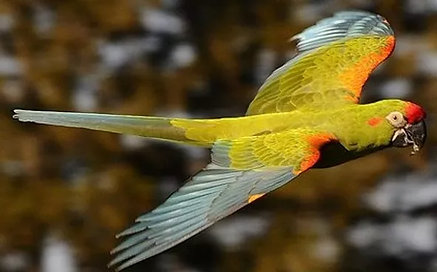
1/24/21
Red-fronted Macaw
Red-fronted macaws, or Ara rubrogenys, are endemic to Bolivia, specifically semi-desert valleys with cold nights and hot days. They are the only macaw to live in such an area. The exact number of them is not known, but it is less than 1,000. They are extremely social and are always found in flocks of 2 - 30 birds. They are playful and have been seen tossing objects around and beak wrestling. They form lifelong monogamous bonds with their mates and are very affectionate even outside of the breeding season. Between April and October they will nest with 1-3 eggs. Unlike most macaws, they nest in crevices and cliffs because of their desert habitat. Both parents care for their chicks until after the breeding season when both parents and children usually join a flock. Red-fronted macaws can fly 40 miles an hour, live up to 50 years, and are the lightest macaw. Red-fronted macaws are called such because of their red forehead and crown. They are very vocal. Red-fronted macaws eat vegetation, vegetables, fruit, nuts, corn, and cacti, from which they also get water. They also chew sticks or bark.
Red-fronted macaws are endangered because of the pet trade and persecution from farmers. They are also threatened by habitat loss, which destroys important food sources. These macaws are considered pests because, as their natural habitat is destroyed for agriculture and firewood, they turn to eating farmers crops, especially their favorite: corn. This is also a problem because of pesticides. Illegal trapping for the pet market has brought the red-fronted macaw closer to becoming extinct in the wild. Thankfully, unlike many macaws, these birds survive well in captivity and can reproduce.

Image by Ellen Aparcicio
These birds are really cool. Why would we want them to go extinct? Also, clashes between wildlife and farmers is a problem for many other animals, including lions, bees, and cheetahs. Any solutions for helping the red-fronted macaw coexist with farmers may also help these other animals, and vice versa.
The Red-fronted Macaw Nature Reserve is a 120 acre area that was created to protect the largest breeding flock of these macaws. Birdwatchers can also come to the reserve, which is run by local communities. This helps local people to make money off helping the environment, as well as selling honey. Researchers are also surveying red-fronted macaw habitats to find out areas where the amount of trapping for the pet trade is high, so we can create a plan. You can help by donating and raising awareness.




Works Cited
Stumpff, E. 2011. "Ara rubrogenys" (On-line), Animal Diversity Web. Accessed October 09, 2020 at https://animaldiversity.org/accounts/Ara_rubrogenys/
Red-fronted Macaws. (n.d.). Retrieved October 09, 2020, from https://www.beautyofbirds.com/redfrontedmacaw.html
Red-fronted Macaw. (2017, July 31). Retrieved October 09, 2020, from https://abcbirds.org/program/communities/red-fronted-macaw/
Cover image by Paul B. Jones

